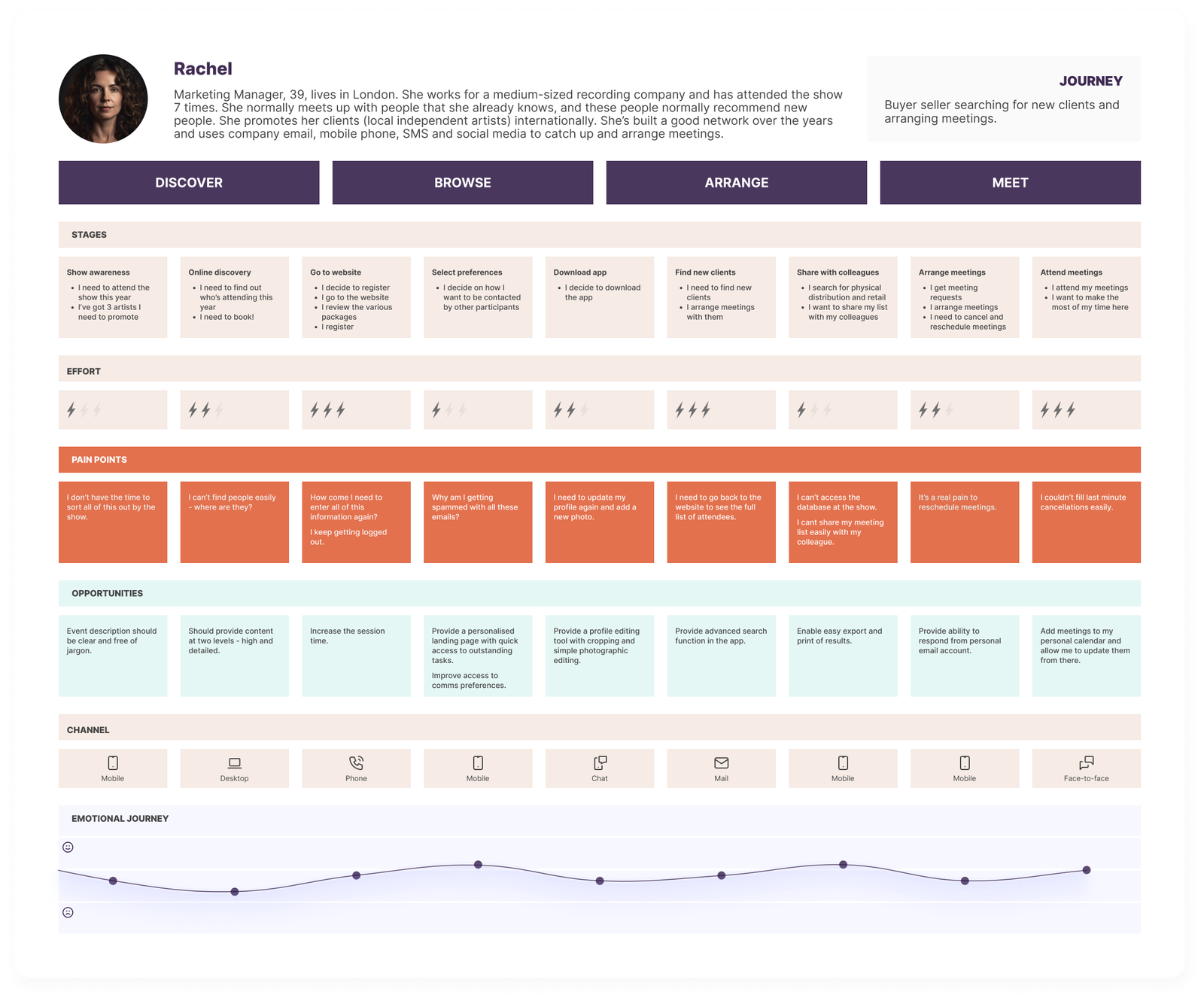Too often, organisations pour money into sophisticated martech stacks such as CRMs, CDPs and automation platforms without the foundational framework needed to orchestrate meaningful, joined-up experiences. One of the most strategic investments a marketing team can make is to deeply understand the journeys that customers take, and customer journey mapping can assist in that.
I’ve seen how transformative journey mapping can be. It’s not just a UX or service design activity, it’s a strategic tool for aligning people, platforms and processes around what matters most: the customer.
What is a Customer Journey Map?
Let’s start with the basics. A Customer Journey Map is a visual representation of every interaction a customer has with your brand, from initial discovery right through to loyalty and advocacy. But more than a diagram, a good customer journey map layers in emotions, motivations, behaviours and barriers, all grounded in real customer data.
It answers key questions such as:
- Who is the customer (persona)?
- What are they trying to achieve?
- What do they feel and experience at each stage?
- Where do they encounter friction, or delight?
- How can you improve their experience across touchpoints?
A robust data collection strategy lays the foundation for deeper insights and informed decision-making.
The key components of a customer journey map
Regardless of format or context, all effective journey maps share five essential building blocks. Understanding and applying these elements is crucial if you want your martech stack to be effective.
1) Persona
The persona is the user or customer experiencing the journey. Each journey map should focus on a single persona to keep the narrative focused and grounded. This persona is typically derived from data and user research and should reflect a specific, real segment of your audience.
For example, an exhibition company mapping the journey of a prospective attendee would use a completely different CJM to one focused on exhibitors. Multiple personas mean multiple maps, each tailored to that user’s goals.
2) Goals and expectations
This defines the situation the map is exploring, what the customer is trying to accomplish and what they expect as an outcome. Scenarios can be based on existing services (e.g. switching utilities) or future designs (e.g. onboarding to a new app).
Good journey maps are focused on processes involving multiple steps, touchpoints, or channels, making them ideal for mapping marketing funnels, onboarding flows, or customer service experiences.
3) Journey phases
These are the high-level stages that the customer moves through, which give structure to the map. While “awareness to advocacy” is a common model, the phases can vary depending on context.
For example:
- E-commerce: Discover → Try → Buy → Use → Seek Support
- B2B: Research → Engage → Evaluate → Purchase → Expand → Advocate
- Services: Book → Attend → Review → Return → Recommend
Martech tools should be aligned with each phase, ensuring consistent, data-driven engagement at every stage.
4) Actions, mindsets and emotions
This section brings the map to life by describing what the customer does, thinks, and feels at each stage. Actions are the key behaviours – searching for a product, reading a review, opening an email. These aren’t exhaustive logs, but headline activities that define the phase.
Mindsets reflect the customer’s thoughts and questions—e.g. “Is this value for money?” or “Can I trust this brand?” Emotions are mapped along a line showing highs and lows throughout the journey, highlighting where delight or frustration occurs.
These elements should be based on qualitative data, such as customer depth interviews, ethnographic research, surveys or usability testing. They form the emotional core of your map, and the strategic insight for your martech to act on.
5) Opportunities
This final layer highlights where the business can improve or innovate. Opportunities are drawn from the entire journey and should directly inform product enhancements, marketing campaigns, or service design.
Ask:
- Where are the biggest drop-offs?
- Where is the customer most frustrated?
- What quick wins could boost conversion or loyalty?
- Who in the organisation owns this part of the experience?
- Your martech tools should be mapped to these opportunities, automating, measuring, or enhancing touchpoints where possible.

Awareness to advocacy
The “Awareness to Advocacy” model, also known as the customer journey funnel or marketing funnel, has its roots in classic marketing and sales theory, and has evolved over more than a century. It’s one of the most common models used when creating a customer journey map since it attempts to explain how advertising moves a consumer from passive awareness to active buying.
1) Awareness
Prospects discover your brand either through advertising, search, word of mouth or content. Here, your martech toolkit should include SEO platforms, paid media integrations, and campaign analytics tools to track where interest originates. Journey mapping reveals which channels work best, and what content resonates most.
2) Consideration
At this point, prospects are actively weighing up their options. Search, social media, forums, comparison guides and review aggregators all play a role here. Customer journey mapping helps to identify what prospects are looking for, so you can tailor your message accordingly.
3) Conversion
The decision to buy. Your martech stack should make this phase as frictionless as possible with seamless checkout flows, personalised offers, triggered cart abandonment emails, and A/B testing tools. Customer journey mapping helps to highlight drop-off points and optimise paths to purchase.
4) Retention
Once someone becomes a customer, the focus shifts to maintaining the relationship. CRM systems, loyalty platforms and lifecycle marketing tools are crucial here. Customer journey mapping reveals key post-purchase moments to engage with personalised comms and offers.
5) Advocacy
Satisfied customers become brand champions. Referral tools, review platforms and community engagement tools all come into play. Customer journey mapping helps to pinpoint opportunities to turn loyal customers into powerful word-of-mouth ambassadors.
Why journey mapping is essential to martech success
Without a journey map, a martech stack can quickly become a fragmented set of tools operating in silos. With one, everything aligns around a common purpose and a shared understanding of the customer.
Here’s how:
- CDPs like Segment, DinMo or mParticle unify customer data and enable journey-stage activation.
- Analytics platforms like GA4, Mixpanel and Hotjar help to identify behavioural patterns and pain points.
- Automation platforms like HubSpot, Salesforce Marketing Cloud or Dotdigital enable personalisation at scale.
- CRM systems such as Braze fuel customer service, retention strategies, and upsell initiatives.
- Loyalty and promotions platforms such as Talon.One drive customer engagement, retention, and conversion by delivering tailored incentives across multiple channels
When integrated and informed by a well-structured customer journey map, your stack becomes more than a collection of tools, it becomes a customer engagement engine.
Activating the journey map with martech
Once you’ve built your CJM, here’s how to put it into action using your martech stack:
- Centralise customer data: Feed all customer interactions across marketing, sales and customer service into a unified data platform or CDP. This removes silos and enables a single customer view.
- Segment by journey stage: Use behavioural data to segment your database based on where customers are in their journey. Tailor content, messaging and tactics accordingly.
- Integrate with channels & tools: Make this segmented data available across platforms for email, social ads, CRM, point of sale, web and app personalisation.
- Run campaigns & optimise: Execute targeted campaigns for each stage of the journey whether it’s awareness-building content, re-engagement ads, or loyalty programmes. Monitor performance and adjust using analytical insights.
Customer journey mapping for strategic alignment
One of the most overlooked benefits of journey mapping is its ability to align teams. Marketing, sales, product, and customer service all benefit from a shared view of the customer journey. This ensures everyone pulls in the same direction, delivering a joined-up, omnichannel experience.
It’s not just about the output either, it’s about the process of developing and maintaining customer journey maps, as well as the conversations that arise with their use.
So before you automate another campaign or launch a new tech platform, ask yourself: Do I really understand my customer’s journey from their point of view? Even the glitziest martech stack won’t help if you’re optimising for the wrong moments.
How Peak Interval can help
At Peak Interval, we can help you unlock the full potential of your marketing and data technology stack. Whether you’re looking to integrate new tools, optimise your existing systems, or develop a tailored customer engagement strategy, our team of experts will guide you every step of the way.
From selecting the right platforms to ensuring seamless data integration and effective product development, we help you make the most of your technology investments. Get in touch today to explore how we can help you achieve your business objectives with a customised approach to your marketing technology needs.
